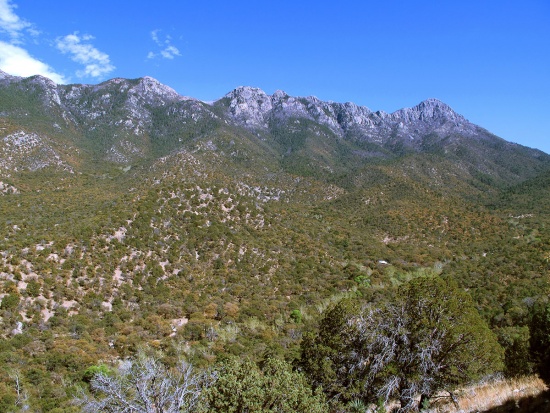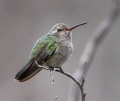| This article is incomplete. This article is missing one or more sections. You can help the BirdForum Opus by expanding it. |

Overview
Located in the far SE corner of Arizona, Madera Canyon is a world-famous birding destination. It is located in the Santa Rita mountains, a relatively moist area for southern Arizona due to altitude; snow collects on the higher peaks to form streams and create a mixed forest with abundant pine and oak trees. Its popularity results not only from the number and variety of birds that gather here, but undoubtedly from the fact that it is just across the border from Mexico, and thus is home to many species more common to the south. Americans who might hesitate to travel across the border can find excellent birding here in a more familiar culture and with a climate that is attractive in winter. There are many other canyons in the area that attract the same birds, but this one has easy access, has several lodges catering to birders, and has trails and public facilities managed by the US Forest Service. The other canyons are heavily grazed and often privately owned.
Birds
Notable Species
Birds that can be found here that are rare or absent to the north include: Arizona Woodpecker, Painted Redstart, Hooded Oriole, Red-faced Warbler, Yellow-eyed Junco, Elegant Trogon, Sulphur-bellied Flycatcher. This is one of the best spots to find several hummingbird species more common in Mexico, including the White-eared Hummingbird, Berylline Hummingbird, and Violet-crowned Hummingbird.
Check-list
Birds you can see here include:
Black-capped Gnatcatcher, Flame-colored Tanager, Gambel's Quail, Scaled Quail, Montezuma Quail, Wild Turkey, Turkey Vulture, Black Vulture, Cooper's Hawk, Northern Goshawk, Red-tailed Hawk, Swainson's Hawk, Zone-tailed Hawk, Golden Eagle, Gray Hawk, Northern Harrier, American Kestrel, Merlin (rare), Prairie Falcon (rare), Peregrine Falcon (rare), White-winged Dove, Mourning Dove, Band-tailed Pigeon, Inca Dove, Common Ground-Dove, Greater Roadrunner, Yellow-billed Cuckoo, Great Horned Owl, Western Screech-Owl, Whiskered Screech-Owl, Elf Owl, Northern Pygmy-Owl, Spotted Owl, Flammulated Owl, Lesser Nighthawk, Common Poorwill, Whip-poor-will, White-throated Swift, Rufous Hummingbird, Broad-tailed Hummingbird, Calliope Hummingbird, Broad-billed Hummingbird, Black-chinned Hummingbird, Anna's Hummingbird, Blue-throated Hummingbird, Magnificent Hummingbird, White-eared Hummingbird, Berylline Hummingbird, Violet-crowned Hummingbird, Elegant Trogon, Ladder-backed Woodpecker, Arizona Woodpecker, Acorn Woodpecker, Northern Flicker, Hairy Woodpecker, Red-naped Sapsucker, Williamson's Sapsucker, Yellow-bellied Sapsucker, Red-breasted Sapsucker, Sulphur-bellied Flycatcher, Northern Beardless-Tyrannulet, Black Phoebe, Say's Phoebe, Olive-sided Flycatcher (rare), Cordilleran Flycatcher, Pacific-slope Flycatcher, Dusky-capped Flycatcher, Ash-throated Flycatcher, Brown-crested Flycatcher, Western Wood-Pewee, Greater Pewee, Western Kingbird, Cassin's Kingbird, Hammond's Flycatcher, Dusky Flycatcher, Gray Flycatcher, Loggerhead Shrike, Plumbeous Vireo, Hutton's Vireo, Warbling Vireo, Bell's Vireo, Cassin's Vireo, Mexican Jay, Steller's Jay, Common Raven, Chihuahuan Raven, White-breasted Nuthatch, Bridled Titmouse, Bushtit, Red-breasted Nuthatch, Pygmy Nuthatch, Verdin, Cactus Wren, House Wren, Bewick's Wren, Canyon Wren, Rock Wren, Winter Wren, Ruby-crowned Kinglet, Blue-gray Gnatcatcher, Black-tailed Gnatcatcher, Black-capped Gnatcatcher, Eastern Bluebird, Western Bluebird, Townsend's Solitaire (rare), Hermit Thrush, Swainson's Thrush, American Robin, Northern Mockingbird, Curve-billed Thrasher, Crissal Thrasher, Phainopepla, Cedar Waxwing, Olive Warbler, Orange-crowned Warbler, Nashville Warbler, Virginia's Warbler, Lucy's Warbler, Yellow Warbler, Yellow-rumped Warbler, Black-throated Gray Warbler, Townsend's Warbler, Hermit Warbler, Grace's Warbler, Wilson's Warbler, MacGillivray's Warbler, Northern Waterthrush (rare), Yellow-breasted Chat (rare), Red-faced Warbler, Painted Redstart, Yellow-rumped Warbler, Black-throated Gray Warbler, Townsend's Warbler, Olive Warbler, Hepatic Tanager, Western Tanager, Summer Tanager, Flame-colored Tanager (rare), Northern Cardinal, Pyrrhuloxia, Black-headed Grosbeak, Rose-breasted Grosbeak, Blue Grosbeak, Varied Bunting, Indigo Bunting (rare), Painted Bunting (rare), Green-tailed Towhee, Canyon Towhee, Spotted Towhee, Botteri's Sparrow, Cassin's Sparrow, Rufous-winged Sparrow, Rufous-crowned Sparrow, Chipping Sparrow, Brewer's Sparrow, Black-chinned Sparrow (rare), Vesper Sparrow, Lark Sparrow, Black-throated Sparrow, Savannah Sparrow, Lincoln's Sparrow, White-crowned Sparrow, Dark-eyed Junco, Yellow-eyed Junco, Eastern Meadowlark (Lillian's), Western Meadowlark, Hooded Oriole, Bullock's Oriole, Scott's Oriole, Brown-headed Cowbird, Bronzed Cowbird, Lesser Goldfinch, House Finch, Pine Siskin, Cassin's Finch (rare), Purple Finch (very rare), Lawrence's Goldfinch (very rare), Red Crossbill (rare).
Gallery of Madera Canyon bird photos by Gary Clark. (Click on an image to enlarge it.)
Other Wildlife
"to do"
Site Information
Location and Access
Drive south from Tucson, Arizona, on Interstate I19 for 25 miles, or north from Nogales for 39 miles to the exit for Continental (Exit 63). Follow the signs southeast to Whitehouse Canyon Road (about 8 miles) and on to the Forest boundary at the mouth of the canyon (another 4 miles). All roads are paved, but rather narrow; large vehicles are discouraged from going further than the mouth of the canyon, and parking in the canyon can be a problem on weekends.
History and Use
"to do"
Areas of Interest
The area along the creek from the mouth of the canyon to the end of the road (about 7 miles) is the prime birding area, with good (even paved) paths allowing access on both sides of the creek for most of its length. To see higher altitude species, one must drive to the parking area at the top and hike one of the fairly strenuous trails. Also of interest are hummingbird feeders at the lodging sites, notably at the Santa Rita Lodge, which maintains a large array of feeders, including seed feeders which attract passerines and ground feeders such as turkeys and doves.
Access and Facilities
- Several commercial lodging enterprises (see links below)
- Excellent trail system along both sides of the creek and from the end of the road into the mountains.
- Public toilets (Forest Service)
- Interpretive displays at parking spots and along trails.
Contact Details
Coronado National Forest.







